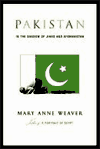| |
BOOK
REVIEW
Pakistan: The
world's next failed state?
Pakistan: In the Shadow of Jihad and
Afghanistan, by Mary Anne Weaver
Reviewed by Sreeram Chaulia
 Since
September 11, 2001, no country has captured the
attention of US policymakers and news analyzers
as much as Pakistan. A plethora of
current-affairs pundits in the United States,
whose visions rarely crossed the Middle East,
rediscovered forgotten Pakistan as it turned
overnight from a "peripheral" state,
in Richard Haas' foreign-policy priority
classification, into a "vital" state
for the conduct of the war on terrorism. Unlike
these opportunist "experts", Mary Anne
Weaver has written on Pakistan and its
surrounding region for more than 20 years. She
is rightfully a South Asia specialist, immensely
experienced, possessing access to the most
important movers and shakers of the region. Since
September 11, 2001, no country has captured the
attention of US policymakers and news analyzers
as much as Pakistan. A plethora of
current-affairs pundits in the United States,
whose visions rarely crossed the Middle East,
rediscovered forgotten Pakistan as it turned
overnight from a "peripheral" state,
in Richard Haas' foreign-policy priority
classification, into a "vital" state
for the conduct of the war on terrorism. Unlike
these opportunist "experts", Mary Anne
Weaver has written on Pakistan and its
surrounding region for more than 20 years. She
is rightfully a South Asia specialist, immensely
experienced, possessing access to the most
important movers and shakers of the region.
In the mold of CNN's Anita Pratap, she has
covered Pakistani and Afghan politics for The
New Yorker with a blend of professionalism,
courage and compassion, qualities on display in
this new book that asks troubling questions
about Pakistan's stability as a state and
reliability as a bulwark against militant Islam.
Profusion of drugs, arms, private militias,
fundamentalist ideologies and sectarian violence
has led to an "accumulation of disorder in
Pakistan such that it could well be the next
Yugoslavia" (p 7). Whichever place in
Pakistan Weaver visited in 2001, "there was
a tangible fear that Pakistan was drifting,
perhaps inexorably, toward chaos ... one of the
most frightening places on Earth". Weaver's
gut feeling expressed in the preface is that
Pakistan's structural weaknesses are so advanced
that it "could well become the world's
newest failed state - a failed state with
nuclear weapons" (p 10). The next major day
of terror in the United States could also come
from this combustible and volatile country,
whose military rulers halfheartedly agreed to
assist Washington against the Taliban when
cornered with implied threats of diplomatic and
aid embargo.
Weaver's first chapter sketches President
General Pervez Musharraf, the man who sits
uneasily astride a "country that is angry
and out of control". His dispute with Prime
Minister Nawaz Sharif centered on Pakistan's
Kargil intrusion of 1999 into Jammu and Kashmir,
which led to a quasi-war with India. Army chief
Musharraf considered the misadventure a
"major tactical coup" and was sore
that Sharif ordered a withdrawal under US
pressure. Musharraf's hawkish anti-India
tendencies were also revealed when his airplane
was disallowed from landing in Karachi on
Sharif's order (October 1999), and the pilot
informed him that the Indian city of Ahmadabad
was open for an emergency stop. The
ex-commando's reply was brusque: "We're not
going to India! Over my dead body will we land
there!" (p 15) According to one old
Musharraf colleague, "when India and
Kashmir come up, he's transformed into a
hardline table-thumper". Working his way up
the army ladder, Musharraf spent his
"entire adult life battling India" (p
28).
On the domestic front, his "western
cowboy" image notwithstanding, Musharraf
has been unable or unwilling to rein in the
state-nurtured Islamist terrorist networks
fanning jihads around the world. Weaver thinks
it is the result of his power base, an army that
is increasingly anti-American and
fundamentalist. In his three-year reign,
Musharraf has acquiesced recurrently to the
pressures of the religious right. The Human
Rights Commission of Pakistan labels him a
"silent spectator in the rise of the
orthodox clergy and militant Islam" (p 36).
Before September 11, under Musharraf, Pakistan's
backing of the Taliban had risen to client-state
proportions. In a face-to-face interview,
Musharraf parried Weaver's questions about the
rise of fundamentalist forces, saying "all
this talk about madrassas teaching
militancy is just hearsay". Musharraf's
responses on squeezing Islamist extremism in
Pakistan were "unforthcoming, even
misleading at times" (p 39).
Chapter 2 recalls the fatal swing Pakistan took
toward Kalashnikov and jihad culture under
Musharraf's mentor, General Zia-ul-Haq.
Pakistan's role as a frontline state in the
first Afghan jihad, starting in 1980, resulted
in a profligate slippage and diversion of arms,
opium and oil from the US Central Intelligence
Agency's pipeline by the Inter-Services
Intelligence (ISI). Fifty percent of US arms
(including 500 Stinger missiles) never reached
the battlefields of Afghanistan. The US
"intentionally or not, launched Pan-Islam's
first holy war in eight centuries" by
massively aiding the ISI and its favorite
Islamists. The lethal formula of parlaying
popular unrest into holy wars, tested in
Afghanistan, went on to be applied by the ISI in
the Kashmir proxy war against India.
Zia's militarization and his focus on jihad
deepened anti-Punjabi fissures in Pakistani
society. Weaver recounts a 1983 meeting with the
leader of Sindhi separatism, G M Syed, in house
prison. Question: "Why are the Sindhis so
angry?" Answer: "Because we are
dominated by Zia's Punjabis." One encounter
with the powerful Khan of Kalat in Balochistan
reinforced this deep sense of insecurity felt
among minorities in Pakistan. "Pakistani
Army raided this very house. They took away my
father. There were many more army operations -
and then you ask us why we are
anti-Pakistan" (p 100).
Chapter 3 sojourns into the tribal areas of
Balochistan, a fiercely independent and Islamist
province of Pakistan. Of the 5,000 or more
Taliban and al-Qaeda fighters who had slipped
into Pakistan by March 2002, the majority
sneaked in from Balochistan, adding to the
"returnees" from the anti-Soviet
jihad. The mass influx of Osama bin Laden
supporters transformed Balochistan and its
adjoining North West Frontier Province "the
world's next Afghanistan" (p 87). In
Quetta's Smugglers Bazaar, Weaver found dealers
selling anti-tank rockets, launchers, AK-47s,
light cannon, landmines and grenades. "A
bullet costs only one rupee; an egg costs
two" (p 118).
Anti-Pakistan secession movements are benefiting
from the open availability of deadly arms. The
leader of the rebellious Marri tribe, Humayun
Khan, told Weaver, "We're being exploited
and neglected. We're bitter, we're angry, we're
armed" (p 106). Baloch music in the remote
town of Turbat carried chants of "May Allah
curse the Pakistani government and martial
law". So suspicious are Baloch youth and
nomads of Pakistani rulers that road-building
personnel of the central government are pelted
with rocks as an alleged part of a plot by
Musharraf and the United States to take over the
Makran coast.
Chapter 4 is an account of the Wahhabi Saudi
Arabian sway over Pakistan, cultivated by both
military and civilian governments in Islamabad.
Through the medium of the houbara bustard bird,
which is hunted rapaciously by Saudi elites in
Pakistan, Weaver goes to the heart of Pakistan's
Arabic orientation.
Billionaires from Riyadh, Doha, Manamah, Dubai,
etc entered Pakistan from the 1970s to shoot the
endangered houbara to near-extinction. Agha
Abedi, the Pakistani founder of Bank of Credit
and Commerce International (BCCI), arranged
hunting outings for the sheikhs in return for
walloping bank deposits. When the BCCI collapsed
a few years ago, the question cropped up:
"How did Pakistan become so enmeshed with
the interests of one bank?" (p 134) Arab
dignitaries who pumped wealth into the bank and
greased the palms of Pakistani generals were
given diplomatic immunity even when less
powerful Pakistanis got arrested and prosecuted
for houbara poaching. Conservationists view the
non-application of environmental regulations on
Arab guests as a case of sheer hypocrisy on the
part of the government.
But there are profounder reasons for the exalted
treatment of Arabs in Pakistan. As they have
been doing in the rest of the Muslim world,
Saudis are the primary financiers of Pakistan's
Sunni supremacists and Islamist terrorists.
Besides funding the thousands of mujahideen and madrassas,
they bankrolled the government of Pakistan with
about US$3.5 billion in annual military and
economic aid in Zia's time. Pakistan's emergence
as the leading figure in the world of militant
Islam owes a great deal to the oil wallahs from
the Persian Gulf.
Chapter 5 takes a close personal look at Benazir
Bhutto, the former prime minister, who now lives
in exile in London. Weaver sees Benazir, the
avowed secularist, as the incubator of the
Taliban during her tenure in power. Musharraf,
as Benazir's director general of military
operations, had helped her spawn the Taliban in
the mid-'90s. Her inability to improve
Pakistan's appalling human-rights record on
women and her reliance on religious motifs to
survive in a highly conservative Islamic polity
doomed her prime ministership. She had to cede
control of Pakistan's nuclear program, its
high-risk policy in Afghanistan and the
anti-Indian war in Kashmir to the generals. Her
influence on the ISI was minimal, as the latter
intervened in fundamentalist movements across
the world.
Weaver remembers Benazir's election rallies in
Rawalpindi where her supporters fired AK-47s
with gay abandon and sang, "Listen, all you
holy warriors." Benazir's failure in
politics is summed up in one sentence:
"Pakistan is not an easy country for
anyone, let alone a woman, to rule" (p
179). Her promise of "breaking the
stranglehold of the Islamic clerics" never
materialized.
Chapter 6 discusses the growing Talibanization
of Pakistan, a process Weaver denotes as
Afghanistan moving farther east into South Asia.
Musharraf's public rhetoric on dealing firmly
with homegrown Islamist terrorists has not been
accompanied by concrete actions, leading many in
Washington to doubt how dependable and ally
Pakistan can be.
Weaver reports seeing shops in Miram Shah, a
tiny town of the Waziristan area, where for only
$100, Taliban and al-Qaeda escapees were shaved,
issued new sets of clothes and sent into major
Pakistani cities with false identity papers. A
few miles from there, in Parachinar, "the
mullahs announced to everyone assembled that
they should kill Americans on sight" (p
221).
Weaver personally received e-mails from publicly
banned Pakistani terrorist claques
"informing us that they were going
underground to regroup and that we would be
receiving their new e-mail addresses and
websites" (p 222). Osama bin Laden
underwent dialysis treatment in a military
hospital in Rawalpindi and, according to Afghan
intelligence, was under the protection of
Maulana Fazlur Rehman of Pakistan's
Jamiat-ul-Ulema-I-Islam in December 2001. Most
frightening, a Pakistani official told Weaver
that the maverick nuclear scientist Bashiruddin
Mahmood, who is a proponent of Islamic science,
"failed six or seven lie-detector
tests" when interrogated on his meetings
with al-Qaeda top brass. Peace envoy Anthony
Zinni reckons, "in a few years, Pakistan's
nuclear weapons could fall into the hands of
religious extremists" (p 266).
Musharraf himself has a queasy past regarding
bin Laden. In 1999, before his coup, Nawaz
Sharif was asked by Washington to set up a
special commando unit to capture or eliminate
the man responsible for the Kenya-Tanzania
bombings. The project was "scuttled by the
ISI" upon Musharraf's nod. Even earlier, in
1998, Prince Turki of Saudi Arabia sought
Islamabad's intervention with the Taliban to
extradite bin Laden. Musharraf "opposed the
Saudi move" (p 247).
Weaver's final chapter delves into Kashmir. The
same policies of holy war against India that Zia,
Benazir and Sharif followed are today being
applied with renewed vigor by Musharraf. The
seemingly unlimited funds that Pakistan
allocates to the jihad in Kashmir come not only
from its own coffers but also Libya, Saudi
Arabia, Europe and North America. By 2000,
Pakistan's military spending alone was greater
than all of its development spending combined.
Much of this goes into helping mujahideen
infiltrate across the Line of Control. Weaver
witnessed Pakistani soldiers giving these
irregular troops "rations, weapons and
ammunition, and even air cover, if need
arose" (p 258).
US intelligence estimates that 300 or more al-Qaeda
Arabs are active in Kashmir on both sides of the
Line of Control, besides participating in Sunni-Shi'a
battles and attacks on Westerners inside
Pakistan. Against the overwhelming evidence,
Musharraf remonstrated to Weaver in an
interview: "All this talk of private armies
is total nonsense. These men are freedom
fighters, not terrorists!" One prominent
Pakistani liberal put Musharraf's stand on
militant Islam thus: "He's got this agenda
in Kashmir. And he is using the Islamists'
fervor for the battle of Kashmir" (p 271).
In the process of exporting battles all over the
region, Pakistan itself has been converted into
a battleground. The jihad has come home.
Weaver's book suffers from a few factual and
descriptive inaccuracies. Musharraf is wrongly
absolved of any role in Zia's Afghan jihad and
Indian Prime Minister Atal Bihari Vajpayee is
oddly termed a "strident Hindu
nationalist", a representation neither his
foes nor his friends would agree with. The
narrative of the book is also disconnected, with
plenty of non sequiturs between chapters.
To Weaver's credit, she has packaged plenty of
anecdotal evidence that many are not familiar
with, especially not in the West. Readers are
left pondering whether Pakistan will indeed fall
deeper and deeper into the quagmire of
lawlessness and state failure and whether more
Ramzi Yousefs and Aimal Kansis (both came from
Balochistan) are going to hit the United States
hard in vulnerable spots.
Pakistan: In the Shadow of Jihad and
Afghanistan, by Mary Anne Weaver,
Farrar, Straus and Giroux, November 2002, New
York. ISBN: 0-374-22894-9. Price: US$24. 285
Pages.
(©2002 Asia Times Online Co, Ltd. All rights
reserved. Please contact [email protected]
for information on our sales and syndication
policies.) |
| |
|
|
 |
|




 Since
September 11, 2001, no country has captured the
attention of US policymakers and news analyzers
as much as Pakistan. A plethora of
current-affairs pundits in the United States,
whose visions rarely crossed the Middle East,
rediscovered forgotten Pakistan as it turned
overnight from a "peripheral" state,
in Richard Haas' foreign-policy priority
classification, into a "vital" state
for the conduct of the war on terrorism. Unlike
these opportunist "experts", Mary Anne
Weaver has written on Pakistan and its
surrounding region for more than 20 years. She
is rightfully a South Asia specialist, immensely
experienced, possessing access to the most
important movers and shakers of the region.
Since
September 11, 2001, no country has captured the
attention of US policymakers and news analyzers
as much as Pakistan. A plethora of
current-affairs pundits in the United States,
whose visions rarely crossed the Middle East,
rediscovered forgotten Pakistan as it turned
overnight from a "peripheral" state,
in Richard Haas' foreign-policy priority
classification, into a "vital" state
for the conduct of the war on terrorism. Unlike
these opportunist "experts", Mary Anne
Weaver has written on Pakistan and its
surrounding region for more than 20 years. She
is rightfully a South Asia specialist, immensely
experienced, possessing access to the most
important movers and shakers of the region.



